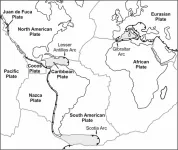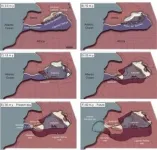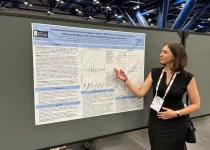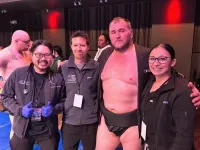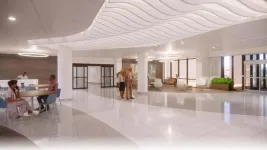(Press-News.org) Contributed by Arianna Soldati, GSA Science Communication Fellow
Our planet’s lithosphere is broken into several tectonic plates. Their configuration is ever-shifting, as supercontinents are assembled and broken up, and oceans form, grow, and then start to close in what is known as the Wilson cycle.
In the Wilson cycle, when a supercontinent like Pangea is broken up, an interior ocean is formed. In the case of Pangea, the interior ocean is the Atlantic. This ocean has a rift in the middle, and passive margins on the side, which means no seismic or volcanic activity occurs along its shores. Destined to keep expanding, an Atlantic-type ocean will eventually become the exterior ocean of the next supercontinent. Currently, Earth’s exterior ocean is the Pacific. The Pacific also has a rift in the middle, but it is bounded by subduction zones and thus will eventually close. Along its margins, earthquakes and eruptions abound—a pattern known as the ring of fire.
The ocean-closing phase of each Wilson cycle requires the transition from passive to active (subducting) margins at the edges of the interior ocean. The oceanic crust along the coast of the Atlantic is old and heavy, so it is primed to subduct, but before it can do so, it must break and bend. The only force in nature that can break oceanic plates like these is slab pull from another subduction zone.
But this doesn’t happen spontaneously. So how does subduction initiate around interior oceans?
There currently are two subduction zones in the Atlantic: the Lesser Antilles and Scotia. But neither of them formed spontaneously in the Atlantic; they were forced by subduction zones in the Pacific during the Cretaceous and then propagated along transform margins, where the continent is narrow and there is barely a land bridge. They jumped oceans.
Today, on the eastern shore of the Atlantic, in Gibraltar, we have the opportunity to observe the very earliest stages of this process, known as subduction invasion, while the jump occurs from a different basin—in this case, the Mediterranean.
This is an incredibly valuable opportunity because the chances of observing the very start of any given tectonic process are limited. And subduction initiation is difficult to observe because it leaves almost no traces behind. Once subduction starts, it erases the record of its initial stages; the subducted plate ends up in the mantle, never to be exposed at the surface again (except in the rare case of ophiolites).
The activity of the Gibraltar subduction zone in the Mediterranean has been hotly debated. The Gibraltar arc formed in the Oligocene as a part of the Western Mediterranean subduction zones. While we can see a subducted plate in the mantle underneath it, almost no further movement is currently happening.
A new paper by Duarte et al., just published in Geology, suggests that Gibraltar is active—it is just currently experiencing a slow movement phase because the subducting slab is very narrow, and it is trying to pull down the entire Atlantic plate.
“[These are] some of the oldest pieces of crust on Earth, super strong and rigid—if it were any younger, the subducting plate would just break off and subduction would come to a halt,” explains Duarte. “Still, it is just barely strong enough to make it, and thus moves very slowly.”
A new computational, gravity-driven 3-D model, developed by the authors, shows that this slow phase will last for another 20 million years. After that, the Gibraltar subduction zone will invade the Atlantic Ocean and accelerate. That will be the beginning of the recycling of crust on the eastern side of the Atlantic, and might be the start of the Atlantic itself beginning to close, initiating a new phase in the Wilson cycle.
Broadly, this study shows that subduction invasion, the process whereby a new subduction zone forms in an exterior ocean and then migrates to an interior ocean, is likely a common mechanism of subduction initiation in Atlantic-type oceans, and thus plays a key role in the geological evolution of our planet.
Locally, the finding that the Gibraltar subduction is still currently active has important implications for seismic activity in the area. Recurrence intervals are expected to be very long during this slow phase, but the potential for high-magnitude events, such as the 1755 Lisbon earthquake, remains and requires preparedness.
Much remains to be figured out about the future of the Gibraltar arc. One of the next aspects that Duarte will focus on is determining the exact geometry of the subduction, which will require assessing the relative strength of the nearby continental margins.
FEATURED ARTICLE
Gibraltar Subduction Zone Is Invading the Atlantic
João C. Duarte, Nicolas Riel, Filipe M. Rosas, Anton Popov, Christian Schuler, Boris J.P. Kaus
https://doi.org/10.1130/G51654.1
Contact: João Duarte, University of Lisbon, jdduarte@fc.ul.pt
GEOLOGY articles published ahead of print are online at https://pubs.geoscienceworld.org/geology/early-publication. Representatives of the media may obtain complimentary copies of articles by contacting Katie Busser. Please discuss articles of interest with the authors before publishing stories on their work, and please make reference to GEOLOGY in articles published. Non-media requests for articles may be directed to GSA Sales and Service, gsaservice@geosociety.org.
###
END
Early-stage subduction invasion
2024-02-15
ELSE PRESS RELEASES FROM THIS DATE:
Targeting the transporter
2024-02-15
When an enemy invades, defenders are ferried to the site to neutralise the marauders. In the human body, a protein carrier called SPNS2 transports S1P molecules from endothelial cells to rally immune cell response in infected organs and tissues.
Using specially-developed nanobodies that bind to SPNS2 and enlarge the entire structure, the enlarged SPNS2 structure allows the S1P molecules to be viewed via cryogenic electron microscopy. Scientists from the Immunology Translational Research Programme at the Yong Loo Lin School of Medicine, ...
AERA announces 2024 Fellows
2024-02-15
WASHINGTON, February 15, 2024—The American Educational Research Association (AERA) has announced the selection of 24 exemplary scholars as 2024 AERA Fellows. The AERA Fellows Program honors scholars for their exceptional contributions to, and excellence in, education research. Nominated by their peers, the 2024 Fellows were selected by the Fellows Committee and approved by the AERA Council, the association’s elected governing body. They will be inducted during a ceremony at the 2024 Annual Meeting in Philadelphia on April 12. With this cohort, there will be a total of 762 AERA ...
Hackensack meridian health biologist-turned-med student publishes COVID-19 vaccine study
2024-02-15
First-year Hackensack Meridian School of Medicine (HMSOM) student Elizabeth Titova leveraged her background in phlebotomy and scientific research to publish a new clinical study around COVID-19 vaccination in Microbiology Spectrum, a peer-reviewed, open-access ASM Journal.
In her study, Titova found that while naturally stronger in immunocompetent individuals, the immunocompromised population—”especially cancer patients undergoing treatment”—still received a “robust immune response” from the vaccine, indicating protection against SARS-CoV-2.
This ...
Burnout: identifying people at risk
2024-02-15
It is not uncommon for people to “hit the wall” at work and experience burnout for short or long periods of time.
“We have found that approximately 13 per cent of Norwegian employees are at high risk of burnout,” says Leon De Beer, Associate Professor of Work and Organizational Psychology at the Norwegian University of Science and Technology (NTNU) Department of Psychology.
De Beer has contributed to a new study on burnout published in the Scandinavian Journal of Psychology with colleagues from the Healthy Workplaces research group.
They are working on a new tool that can identify people at risk of burnout. ...
Study reveals accelerated aging in women living with HIV
2024-02-15
Women with HIV experience accelerated DNA aging, a phenomenon that can lead to poor physical function, according to a study led by Stephanie Shiau, an assistant professor in the Department of Biostatistics and Epidemiology at the Rutgers School of Public Health.
Published in The Journal of Infectious Diseases, the study sheds light on the unique challenges faced by women with HIV as they age and opens avenues for tailored interventions to enhance health outcomes. Globally, over 50 percent of individuals living with HIV are ...
How parents can help prevent the development of ADHD symptoms
2024-02-15
Parents of young children with an excitable or exuberant temperament could adapt their parenting style to help moderate their child’s potential development of Attention Deficit/Hyperactivity Disorder (ADHD), according to a new study co-authored by a University of Waterloo researcher.
Developmental psychologists know that temperament, parenting, and the brain’s executive functions are interconnected factors in developing ADHD symptoms throughout childhood. But, the study found specific factors that predict a higher chance of ADHD symptoms, pointing to the importance ...
Meow or rooaaar - exotic cats' ability to recognize familiar caregivers' voices
2024-02-15
In a recent PeerJ Life & Environment study, Professor Jennifer Vonk from Oakland University presents compelling evidence that exotic cats possess the remarkable ability to discriminate between familiar and unfamiliar human voices.
The article - "Catcalls: Exotic Cats Discriminate the Voices of Familiar Caregivers" - delves into the often-overlooked realm of voice recognition among Felidae species. While much attention has been paid to domestication and early experiences in understanding animals' ability to differentiate between ...
Dementia researchers share recruitment strategies for pragmatic clinical trial
2024-02-15
WINSTON-SALEM, N.C. – Feb. 15, 2024 – According to the Alzheimer’s Association, more than 6.5 million Americans are living with Alzheimer’s disease, and 1 in 3 older adults will die with the disease or another form of dementia. There’s also a growing need for improved care and support, not only for persons living with dementia but also for their caregivers.
Underrepresented populations are disproportionally more likely to have Alzheimer’s disease compared to other Americans, so there’s ...
Mount Sinai named official medical service provider for International Sumo League
2024-02-15
For the first time, the Mount Sinai Health System has been named the official medical service provider for the International Sumo League—the world’s largest league of sumo wrestlers. Physicians from the Department of Rehabilitation and Human Performance are playing a key role in preparing the elite sumo wrestlers competing in international tournaments, including the upcoming World Championship Sumo at the Prudential Center in New Jersey on Sunday, February 18.
“We are excited to partner with International Sumo League and offer comprehensive care and expert guidance ...
Nation's newest, most comprehensive blood cancer healing center to transform care landscape
2024-02-15
The Blood Cancer Healing Center, located at 3229 Burnet Avenue in Uptown Cincinnati, is poised to redefine care standards by offering comprehensive patient support and innovative treatments under one roof. With clinical services opening as part of a phased approach in the summer of 2024, this state-of-the-art facility will address the critical needs of the 1.6 million individuals affected by blood cancers, such as leukemia, lymphoma and myeloma, annually in the U.S. Other spaces within the facility are scheduled to open in 2025.
Care will be given around the clock in both the inpatient ...
